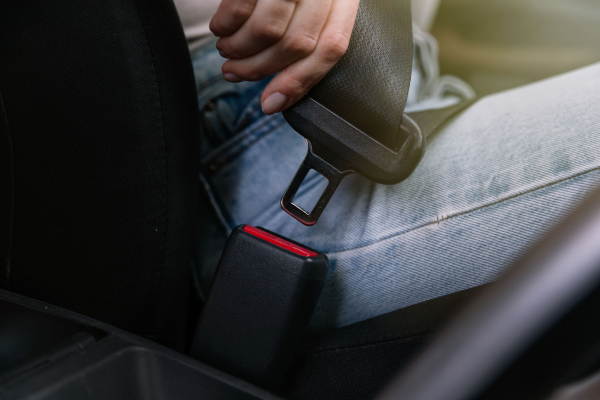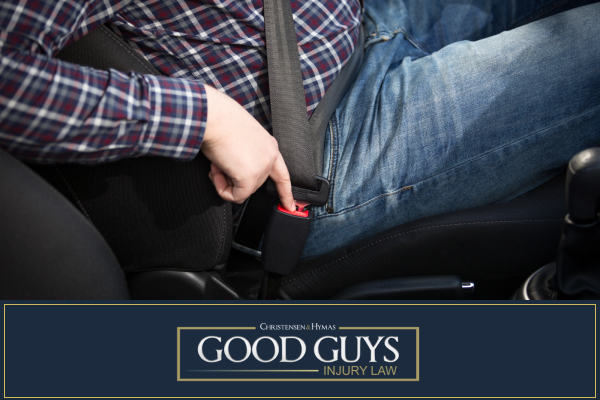
Seat belts are essential for safety but can also cause injuries in certain situations. While they can protect you during a car accident, if they do not work correctly, they may cause harm instead. Common issues include seat belt failure, faulty designs, or injuries caused by improper restraint.
Good Guys Injury Law helps victims of seat belt-related injuries. If a defective seat belt caused your injuries, you might have a case for a personal injury lawsuit. Awareness of how seat belts work and when they can cause harm is the first step toward protecting your rights.

Reach to Our Good Guys
Injury Law for a
Free Consultation On Your Case
Table of Contents
How Does a Seat Belt Work?
A seat belt is a safety device that keeps you secure during a car accident. It restrains your body and reduces movement, preventing you from hitting the dashboard, windshield, or other passengers. Seat belts work by locking in place when the car stops suddenly, absorbing the force of the crash.
The seat belt system includes a lap belt and a shoulder strap. These work together to spread the force of the collision across stronger parts of the body, like the chest and pelvis. When used properly, a seat belt can prevent many serious injuries. However, if a seat belt fails or is defective, it may cause more harm than protection.
When Does a Seat Belt Lead To Injuries?

Even when used properly, a seat belt can cause harm in certain situations. High-speed crashes or seat belt failure may result in injuries. For instance, when the seat belt system applies too much pressure during a collision, it can lead to bruises or internal damage.
In some cases, defective seat belts or improper designs can fail to fully restrain the passenger. A loose shoulder strap or weak locking mechanism increases the risk of injury. If a seat belt defect causes harm, it might result in serious injuries requiring medical attention. Recognizing these risks helps injured parties take legal action and seek compensation.
Common Seat Belt Injuries

Seat belt injuries can range from minor discomfort to severe trauma. They often occur during high-impact car accidents or when seat belts do not work as intended. Understanding these injuries can help victims seek proper treatment and compensation. Here are some of the most common seat belt-related injuries:
Soft Tissue Damage and Internal Injuries
During a crash, seat belts can press tightly against the body, causing soft tissue injuries or internal damage. The force of the restraint can bruise organs, damage muscles, or tear ligaments. These injuries are not always visible but may result in serious health problems.
Sometimes, pressure from a seat belt may harm the stomach, liver, or other organs. Internal bleeding is another risk that requires immediate medical attention. Victims may experience abdominal pain, swelling, or difficulty breathing after an accident.
Legal action might be necessary if the seat belt failed or excessive force was applied. Compensation can help cover medical expenses and recovery costs. Early diagnosis and treatment are key to preventing complications from internal injuries caused by seat belts.
Fractured Ribs and Clavicles
The shoulder strap of a seat belt can place significant pressure on the upper body during a collision. This often leads to fractures in the ribs or clavicle. These bones are especially vulnerable during high-speed crashes or when the seat belt properly restrains the body but applies too much force.
Fractured ribs can cause severe pain and make breathing difficult. A broken clavicle may restrict arm movement, requiring weeks of rest and possible surgery. These injuries can lead to additional complications, such as punctured lungs or nerve damage.
When a defective seat belt causes injury, victims may have a legal case against the manufacturer. Compensation can cover the costs of lost income and medical expenses during recovery. Proper legal support ensures injured parties get the help they need.
Whiplash and Neck Strain From Sudden Restraint
Seat belts are designed to prevent movement during a crash, but they can sometimes cause whiplash or neck strain. When a seat belt locks suddenly, the neck and head may jerk forward or sideways. This rapid motion often stretches or tears muscles and ligaments in the neck.
Symptoms include pain, stiffness, and reduced movement, lasting for weeks or months. In severe cases, whiplash may require physical therapy or long-term treatment. These injuries are common in rear-end collisions or when a seat belt fails to distribute force evenly.
Victims dealing with whiplash or neck strain often need compensation for damages and losses caused by the injury. Proving that a faulty seat belt contributed to the injury strengthens a legal case. Seeking early medical care and legal advice helps ensure proper recovery and justice.
Causes of Seat Belt Injuries

Seat belt injuries can happen for different reasons. These include the crash’s speed, the seat belt’s condition, or how it was used. Knowing the cause is necessary to determine if the injury could have been prevented. A few main causes of seat belt-related injuries include:
High-Speed Collisions Leading to Excessive Force
High-speed car accidents put extreme force on seat belts, which can cause injuries. While seat belts are designed to protect, the sudden stop of a crash makes the restraint press tightly against the body. This pressure can lead to bruises, fractured ribs, or even internal injuries.
In severe cases, the body’s forward momentum may cause the seat belt system to lock with excessive force. This can injure the chest, abdomen, or neck. Victims often require medical attention to treat these injuries and recover fully.
While seat belts significantly reduce the risk of life-threatening harm, injuries can still occur in high-speed impacts. Victims may be entitled to compensation if a defective seat belt caused the injury or the force was unusually strong. Identifying the cause helps build a stronger case for recovery.
Defective Seat Belt Mechanisms
Sometimes, seat belt defects make injuries worse during a crash. A faulty seat belt may not lock properly, restrain the passenger, or break under pressure. These issues are often linked to poor manufacturing or design flaws.
For example, if the seat belt fails to tighten during a crash, the passenger could hit the dashboard or windshield. This increases the risk of head trauma, chest injuries, or ejection from the vehicle. Victims of accidents involving defective seat belts may pursue legal action against the manufacturer.
Proving that a seat belt defect caused the injury is key in these cases. Medical records, accident reports, and expert evaluations help show how the defect contributed to harm.
Improper Use or Malfunction During an Accident
Improper seat belt use or malfunctions can lead to injuries. For example, wearing the seat belt improperly, such as placing the shoulder strap behind the back, reduces its effectiveness. This can result in injuries like chest bruises or neck strain during a crash.
Malfunctions, such as a jammed buckle or twisted strap, can prevent the seat belt from working correctly. Sometimes, a seat belt fails to hold the passenger in place because of wear and tear. These issues make injuries more severe during an accident.
Victims injured due to misuse or seat belt failures may qualify for compensation. Proving that the injuries were worsened by improper use or a malfunction requires strong evidence. Seeking legal help ensures injured parties get the support they need to recover and move forward.
Filing a Seat Belt Injury Lawsuit
Depending on the case specifics, filing a lawsuit for seat belt-related injuries may help victims recover costs and hold responsible parties accountable. These cases often involve seat belt defects, manufacturing errors, or negligence by car manufacturers.
To build a strong case, you need proof that the seat belt failed or caused harm due to improper design or malfunction. This includes collecting medical records, accident reports, and expert opinions. Victims can seek compensation for hospital bills, lost earnings, and pain and suffering. Legal support ensures your case is handled properly and increases the chances of obtaining fair compensation.
Why You Need a Specialized Personal Injury Lawyer To Fight for You

Seat belt injury cases can be complicated. A personal injury lawyer helps victims overcome these challenges by gathering evidence, proving fault, and negotiating with insurance companies. They ensure you receive fair compensation for medical bills, lost wages, and other damages.
A skilled lawyer can handle every part of the legal process, giving you peace of mind. A few key ways a personal injury lawyer can support your case include:
Negotiate With Insurance
It can be overwhelming to deal with insurance companies after a car accident. Insurers often try to minimize payouts, even when injuries are severe. A personal injury lawyer acts as your advocate, handling all communication and negotiations with the insurance company.
They know how to calculate fair compensation for seat belt-related injuries. Lawyers ensure that insurance companies don’t exploit victims by offering low settlements. A lawyer’s support makes you more likely to receive fair compensation for your injuries and losses.
File a Lawsuit
When negotiations with the insurance company fail, filing a personal injury lawsuit may be vital. A lawyer ensures your case is filed correctly and within the legal deadline. They gather all the necessary evidence, such as medical records and expert testimonies, to prove that a seat belt defect caused your injuries.
Through legal action, victims can hold manufacturers or negligent parties accountable. A lawsuit can recover costs for medical expenses, lost wages, and long-term treatment for severe injuries. With a lawyer guiding the process, you have a better chance of success in getting the compensation you deserve.
Fight for You in Court
A lawyer will represent you every step of the way if your case goes to court. They will present evidence showing how the seat belt failed or caused your injuries. This includes proof of seat belt defects, faulty designs, or improper manufacturing that led to harm.
Your lawyer will argue for maximum compensation to cover financial and emotional losses in court. They will handle cross-examinations, expert witnesses, and all legal procedures. Your case is in the best possible hands with a skilled lawyer fighting for you.
Their goal is to secure justice and ensure you are fully compensated.


Contact Good Guys Injury Law for Your Free Personal Injury Case Consultation
Call Our Utah Seatbelt Injury Lawyer for a Free Consultation

Seat belts are meant to protect, but they can sometimes cause harm. From minor seat belt injuries like bruises to serious injuries such as internal damage or broken bones, the consequences can be life-changing. Improper seat belt usage or defects in the restraint system can cause harm to a safety device. Victims suffering from any serious injury deserve justice and compensation.
Good Guys Injury Law helps individuals affected by seat belt-related injuries. Our experienced lawyers understand the legal complexities of these cases and fight to hold negligent parties accountable. Whether your injury resulted from a defective seat belt or a high-speed crash, we are here to assist.
Contact us today for a free consultation to learn how we can help you recover damages for medical expenses, lost wages, and more.
